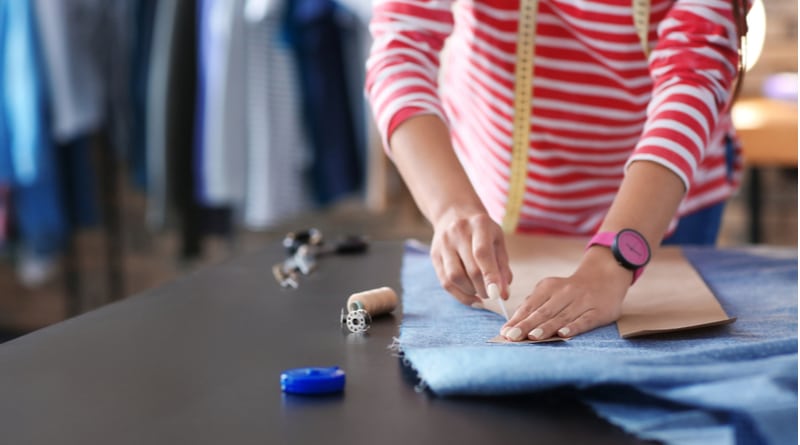What is Pattern Drafting?
Pattern drafting is the process of creating a pattern by taking measurements from a person, form, or model, in order to then create a foundation, which is a pattern used as the basis for the design.
Drafting is often used to create initial designs. These designs are produced using standard sizing presets from factories or have been measured accurately using a fit model. This method is traditionally drawn on paper and has markings for ease allowance to complete the formation of the garment.
What 3rd level courses are available?
Universities and colleges in Ireland are offering courses in Pattern Drafting in the following subject areas:
- Pattern Drafting – Learn the basics of pattern drafting and making garment patterns.
- Fashion Industry & Design – Learn the skills essential to becoming a fashion buyer.
- Introduction to Fashion Design – This course is an introduction to what a fashion designer does and how to draft a pattern and have a final garment professionally produced.
- Fashion Fundamentals – Fashion Fundamentals will appeal to all those interested in fashion and style and who have a desire to learn the basics of the fashion industry.
Studying Pattern Drafting in college
There are many courses in Pattern Drafting that take place over 1 year to 4 years depending on the course and modules selected. There are also part-time courses and night courses available so you can be sure to fit in your studies no matter what your schedule is like.
Courses will cover theory work through lectures, assignments, tutorials and taught modules. Assessments will take place on a continuous basis with written examinations and practical assignments combined in order to achieve a qualification.
You could also consider work experience or a work shadow in the industry. Getting work experience of any kind in a design studio is important. Experience in retail can also be useful. Contact fashion houses, designers, department and other retail stores and supermarket fashion labels to ask for work experience, and look for opportunities on the websites of fashion companies.
Networking is crucial and you can often find employment by establishing relationships with designers and companies. Many courses are structured to provide opportunities to work on projects with leading fashion designers, so you should take advantage of this.
By job shadowing and carrying out work experience assisting a professional in the field you’ll gain valuable insight, develop your portfolio, build a network of contacts and demonstrate your commitment to the profession. Observation is one of the best ways to learn skills and techniques.
Career options
After completing a Pattern Drafting course you will be able to get started in a career that uses specific knowledge of fashion and garment design and production.
Fashion industry employers range from top designers in well-established studios to high street retail outlets, supermarket clothing labels and manufacturing operations. You could consider other less obvious areas, too, such as costume design within the television and film industry, the fashion media, and internet companies. Or you may decide to open your own studio or start your own fashion line.
Working hours will depend on whether you are self-employed, employed by a company with set business hours or if you are contracted to various studios or companies. Working hours typically include regular extra hours to meet project deadlines.
Related jobs include:
- Fashion designer
- Retail buyer
- Retail manager
- Retail merchandiser
- Stylist
- Textile designer
- Visual merchandiser
- Clothing/textile technologist
- Event manager
- Jewellery designer
- Magazine journalist
- Make-up artist
- Public relations officer
- Talent agent
Further study
After completing a course in Pattern Drafting, you may choose to pursue further study in a specialist field to increase your knowledge base and skill set. Postgraduate study can also be used as a means to change career focus or to gain professional qualifications required to practise in certain career areas such as art and design, fashion and fashion design, fashion business. fashion buying, marketing and communication.
FAQ
What is the importance of pattern drafting?
Pattern Drafting is an important part of fashion designing and requires tremendous skills and practice. Pattern drafting is where pattern pieces are drawn on paper according to body measurement which becomes the base for designers to create garments.
What are some tools I should have if I am interested in starting a career in Pattern Making?
- Pattern paper – Pattern making paper is used to draft patterns.
- Cardboard for blocks – Cardboard is typically used to cut out my blocks (sometimes also called slopers). Blocks are standard patterns that fit the body snugly. They are the most basic form of garments that then can be adapted into different garment styles.
- Pattern notcher – Used to cut little notches out of blocks or other cardboard patterns. This makes it very easy to transfer the notches from blocks onto pattern paper.
- Paper scissors – If you are serious about pattern making, you will want to invest in good paper/cardboard scissors because you will be doing a lot of cutting.
- Measuring tape – For measuring long lines on patterns.
- Set square – A ruler with a 90degrees angle and a slight curve on the longest side of the triangle.
- Half scale ruler – It is recommended to use half scale when learning new pattern making skills, it uses less paper, less fabric and is easier to handle.
- Grading ruler – Grading describes the process of transforming a pattern into all the sizes you want to sell/use the pattern in. This ruler helps because it makes shifting a line for a certain amount of millimetres very easy.
- French curve – French curves are used to draw curved lines when pattern making. Traditionally, a pattern has curved lines along the neckline, armholes or following the hip curve.
- Tracing wheel – A tracing wheel is used to transfer pattern markings from cardboard onto paper or sometimes the other way around.
- Sewing pins and a pin cushion – These are used for pinning fabrics together so they do not move.
- Pattern awl – A pattern awl is used to transfer dart points and drill holes from blocks onto the paper pattern.
- Calico – Fabric used to make toiles (test garments). Calico is a cheap, non-stretch, very basic fabric that shows the fit of garments very well.
Where can I study Pattern Drafting?
Explore your options here
Did You Know?
- Archaeologists believe that people used to sew together fur, hide, skin, and bark for clothing as far back as 25,000 years ago.
- The Singer sewing machine was patented by Isaac Merritt Singer in 1851. Singer’s patent was the most dominant firm in the industry compared to other competitors.
- “The whole nine yards,” a common phrase, came from the fabric that was needed to make the fanciest coat for a man of fashion.
- The earliest sewing needles were made of bone between 25,000 and 30,000 years ago.
- When buttons for garments were first invented, only wealthy women can afford them. This is the reason why early women’s clothing have buttons designed on the left side of the garment making them more accessible to servants who help them get dressed.












Comments